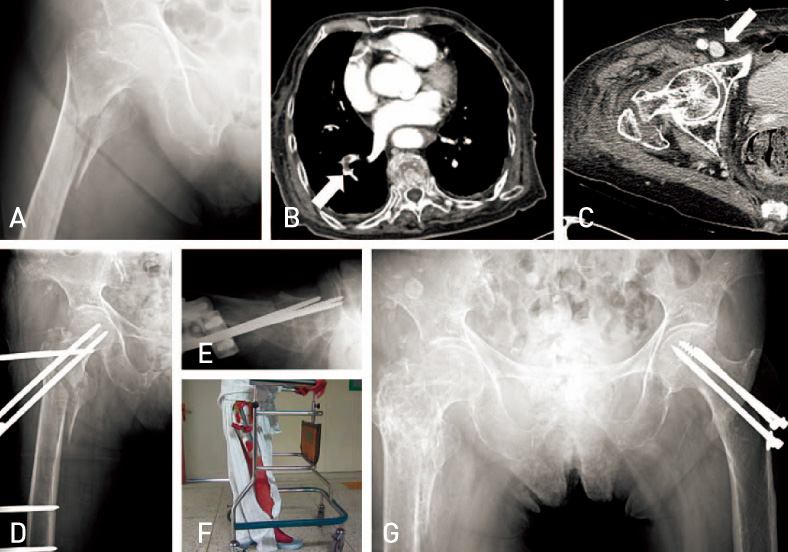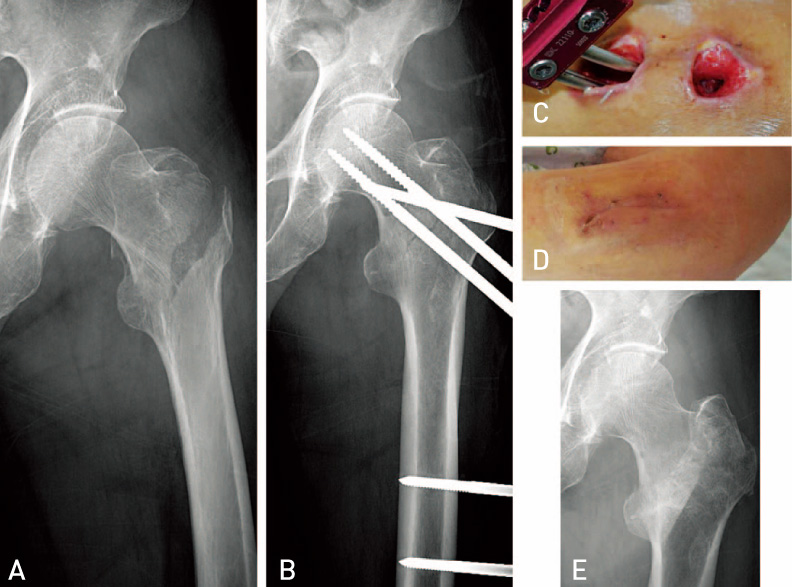Hip Pelvis.
2012 Jun;24(2):153-159. 10.5371/hp.2012.24.2.153.
External Fixation Under Local Anesthesia in Intertrochanteric Fracture Patients with High Anesthetic Risk: 3 Case Reports
- Affiliations
-
- 1Department of Orthopedic Surgery, Seoul Veterans Hospital, Seoul, Korea. yun8813@paran.com
- KMID: 1439105
- DOI: http://doi.org/10.5371/hp.2012.24.2.153
Abstract
- The goals of surgical treatment are to obtain anatomical reduction, obtain stable fixation, and allow early rehabilitation. Results of conservative management of intertrochanteric fractures are not satisfactory due to the increased risk of cardiopulmonary complications related to immobilization. External fixation has been well-established as an alternative treatment modality for intertrochanteric fractures in elderly and medically-compromised patients. The authors reviewed the related literature and reported on three cases of elderly patients that suffered from intertrochanteric fractures and had severe medical co-morbidities. They were successfully treated by external fixation under local anesthesia.
Figure
Reference
-
1. Petsatodis G, Maliogas G, Karikis J, et al. External fixation for stable and unstable intertrochanteric fractures in patients older than 75 years of age: a prospective comparative study. J Orthop Trauma. 2011. 25:218–223.
Article2. Kumar A, Kumar N. Prediction of fixation failure after sliding hip screw fixation [Injury 2004;35:994-8]. Injury. 2005. 36:984–985. author reply 985.
Article3. Ozkaya U, Parmaksizoğlu AS, Gül M, Kabukçuoğlu Y, Ozkazanli G, Basilgan S. Management of osteoporotic pertrochanteric fractures with external fixation in elderly patients. Acta Orthop Traumatol Turc. 2008. 42:246–251.
Article4. Ooi LH, Wong TH, Toh CL, Wong HP. Hip fractures in nonagenarians--a study on operative and non-operative management. Injury. 2005. 36:142–147.
Article5. Karunakar M, McLaurin TM, Morgan SJ, Egol KA. Improving outcomes after pertrochanteric hip fractures. Instr Course Lect. 2009. 58:91–104.6. Cuvillon P, Nouvellon E, Marret E, et al. American Society of Anesthesiologists' physical status system: a multicentre Francophone study to analyse reasons for classification disagreement. Eur J Anaesthesiol. 2011. 28:742–747.7. Richmond J, Aharonoff GB, Zuckerman JD, Koval KJ. Mortality risk after hip fracture. 2003. J Orthop Trauma. 2003. 17:S2–S5.8. Parker MJ, Palmer CR. A new mobility score for predicting mortality after hip fracture. J Bone Joint Surg Br. 1993. 75:797–798.
Article9. Vossinakis IC, Badras LS. The external fixator compared with the sliding hip screw for pertrochanteric fractures of the femur. J Bone Joint Surg Br. 2002. 84:23–29.
Article10. Kuderna H, Bohler N, Collon DJ. Treatment of intertrochanteric and subtrochanteric fractures of the hip by the Ender method. J Bone Joint Surg Am. 1976. 58:604–611.
Article11. Nungu S, Olerud C, Rehnberg L. The treatment of intertrochanteric fractures: comparison of Ender nails and sliding screw plates. J Orthop Trauma. 1991. 5:452–457.12. Cavusoglu AT, Er MS, Inal S, Ozsoy MH, Dincel VE, Sakaogullari A. Pin site care during circular external fixation using two different protocols. J Orthop Trauma. 2009. 23:724–730.
Article
- Full Text Links
- Actions
-
Cited
- CITED
-
- Close
- Share
- Similar articles
-
- Subcapital Stress Fracture of the Femur after Internal Fixation of Intertrochanteric Fracture: A case report
- Ender Nailing of the Tibial Shaft Fractures under the Local Anesthesia
- Avulsion Facture of Short External Rotators in the Proximal Femur: A Case Report
- Fixation Failure after internal Fixation in Intertrochanteric Fractures
- External Fixation and Limited Internal Fixation in AO Type C Pilon Fracture: Report of Five Cases




